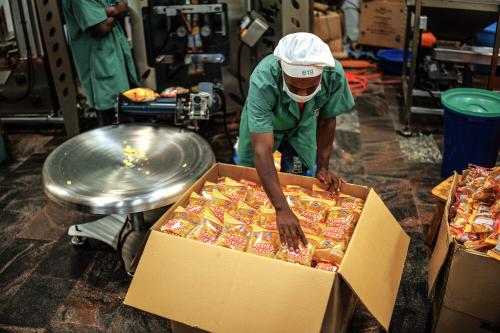
https://www.ifad.org/en/w/explainers/the-scorecard-for-global-hunger-sho...
Hunger
The numbers: About 8.3 percent of the world’s population faced hunger in 2024, decreasing from 8.5 percent in 2023 and 8.7 percent in 2022. This means that up to 720 million people – about one in nine – were undernourished.
Unpacking the data: The progress is driven by improvements in South Asia, Southeast Asia and Latin America. But in almost all regions of Africa and the Middle East, hunger is rising. By 2030, an estimated three in five people who experience hunger will be in Africa.
IFAD’s solution: Tackling hunger requires more than a band-aid – we need to invest in rural transformation to tackle its root causes. And we can’t lose sight of another growing challenge for Africa: a large, young population that struggles to find stable jobs for decent pay.
IFAD is tackling both these problems. In nine African countries, the Agribusiness Hubs Programme works with the private sector to identify opportunities for rural youth while linking them with training and business support in the agricultural sector. The programme has created over 32,000 decent jobs and 7,000 businesses that are increasing sustainable access to nourishing food.
The numbers: In 2024, 28 per cent of the world’s population – about 2.3 billion people – was food-insecure. Unpacking the data: Food insecurity remains more prevalent in rural areas than in urban areas. On top of this, food insecurity is more prevalent among women than among men, as women tend to have more limited resources, weaker social protection and fewer coping mechanisms. As lower-income households spend a larger share on money on food, a small increase in food prices can have significant impacts on their food security. IFAD’s solution: IFAD invests in resilient agrifood systems that reduce spikes in food prices. We also contribute to strong agricultural market information systems, which enable small-scale farmers and consumers to navigate market conditions. Innovatech collaborated with 12 tech start-ups across six Latin American countries and linked them with agrifood value chains. As a result, 382 producer organizations connected with tech-driven solutions, benefiting 21,000 households. Earlier this year, IFAD launched Innovatech 2.0 with US$4 million in financing from IFAD and the EU. The numbers: Global food price inflation peaked at 13.6 per cent in 2023 and has since slowly declined. Unpacking the data: While inflation in food prices is not as acute as immediately after the pandemic or after the start of the war in Ukraine, food prices are still rising at 5.1 percentage points higher than headline inflation. This matters for rural people who may rely on markets to fill the gaps in their food production. Many small-scale farmers are net buyers of food, so even if they can sell their produce for more, this difference may not be able to offset the increased cost of the food they purchase. IFAD’s solution: IFAD is transforming agriculture, food systems and rural economies by connecting rural people to finance, markets, technology and knowledge. These changes build their prosperity, food security and ability to withstand shocks. IFAD invests in small and medium-sized rural businesses and agribusinesses and de-risks additional investment from the private sector. In Uganda, IFAD helped set up the Yield Fund to support local SMEs. After an initial US$14 million investment, it has now reached $23 million in total commitments. The numbers: The average cost of a healthy diet increased to 4.46 purchasing power parity (PPP) dollars per person per day in 2024, up from 4.30 PPP dollars in 2023 and 4.01 PPP dollars in 2022. Unpacking the data: Despite this, the number of people who can afford to eat well is rising. Healthy diets are unaffordable for 2.6 billion people in 2024, down from 2.76 billion in 2019. But the good news doesn’t extend everywhere. Fewer people can afford to buy enough healthy food in Africa, and in low-income and lower-middle-income countries at large. Food price inflation remains high and may worsen food security, particularly in low-income countries. Globally, nutritious foods such as fruits and vegetables continue to become more expensive, while ultra-processed foods are increasingly displacing nutritious alternatives due to their lower prices. IFAD’s solution: Nutrition is integrated into IFAD’s projects. In the Pacific, where rates of nutrition-related diseases such as diabetes and obesity are soaring, IFAD supports small-scale farmers in cultivating diverse, nutrient-rich and climate-resilient indigenous foods. In Kiribati, households participating in OIFWP – which received a US$6.6 million grant from IFAD – reduced their expenditure on imported foods like rice while increasing their consumption of nutritious, locally grown foods like sweet potato and breadfruit.
Food insecurity
Food prices
Healthy diets













